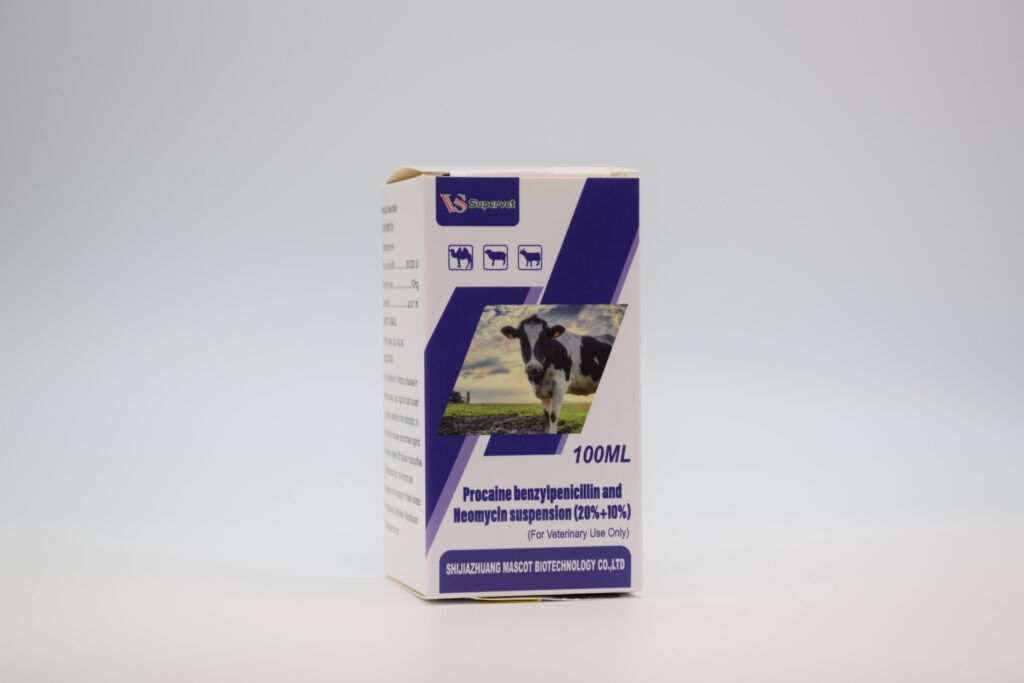
Procaine Benzylpenicillin and Neomycin Sulphate Suspension for Injection
Name:
Procaine Benzylpenicillin and Neomycin Sulphate Suspension for Injection
Common Capacity:
- Injection Solution: 10ml, 20ml, 50ml, 100ml/bottle
Common Concentration:
- Injection Solution: Procaine Benzylpenicillin 20%, Neomycin Sulphate 10%.
Applicable Animals:
This product is a combined preparation of a penicillin antibiotic and an aminoglycoside antibiotic. Procaine Benzylpenicillin primarily has a strong antibacterial effect against Gram-positive bacteria, acting by inhibiting bacterial cell wall synthesis. Neomycin is an aminoglycoside antibiotic with antibacterial effects mainly against Gram-negative bacteria and some Gram-positive bacteria, acting by inhibiting bacterial protein synthesis. The combination exhibits synergistic effects, broadening the antibacterial spectrum, and is suitable for treating bacterial infections in various animals such as pigs, cattle, sheep, and chickens.
- Monogastric Animals (Pigs):
- All stages of pigs: Used for the treatment of bacterial pneumonia, swine erysipelas, streptococcosis, pleuropneumonia, gastroenteritis, and other infections caused by susceptible bacteria.
- Ruminant Animals (Cattle, Sheep):
- Cattle, Sheep: Used for the treatment of pneumonia, mastitis, metritis, enteritis, and other bacterial infections.
- Poultry (Chickens):
- Used for the treatment of E. coli disease, salmonellosis, chronic respiratory disease, and other bacterial infections caused by susceptible bacteria.
Usage and Dosage:
This product is an injectable solution, primarily administered via deep intramuscular injection. Specific dosage and duration of treatment should be determined based on the animal species, body weight, age, disease severity, and veterinary diagnosis.
Intramuscular Injection:
- Pigs:
- Piglets/Growing Pigs: 0.1ml-0.2ml per kg body weight, once daily for 3-5 consecutive days.
- Adult Pigs (Sows/Fattening Pigs): 0.1ml per kg body weight, once daily for 3-5 consecutive days.
- Cattle, Sheep:
- 0.1ml per kg body weight, once daily for 3-5 consecutive days.
- Chickens:
- 0.1ml per kg body weight, once daily for 3-5 consecutive days. (Note: For chickens, due to their small size, large-group administration via diluted drinking water or mixed feed is more common; injectable administration is typically for individual treatment.)
Dosage by Growth Stage:
- Neonatal Animals: When used in newborn piglets, calves, and lambs, the dose must be strictly controlled to avoid overdose. Procaine Penicillin has a relatively high safety margin, but Neomycin has ototoxicity and nephrotoxicity, requiring extreme caution in neonatal animals.
- Pregnant and Lactating Animals: The risks should be thoroughly evaluated before use in pregnant and lactating animals. Penicillin-class drugs are relatively safe, but Neomycin has embryotoxic and nephrotoxic potential and is not recommended during pregnancy, or should be used only under strict veterinary guidance.
Applicable Diseases and Symptoms:
This product is mainly used for the treatment of infections caused by bacteria sensitive to Penicillin and Neomycin.
- Respiratory System Infections:
- Pigs: Streptococcosis, infectious pleuropneumonia, Haemophilus parasuis disease, Mycoplasma pneumonia (for bacterial secondary infections). Symptoms include coughing, wheezing, dyspnea, depression, and decreased feed intake.
- Cattle, Sheep: Pneumonia, respiratory infections.
- Digestive System Infections:
- Pigs: Bacterial gastroenteritis, yellow and white scours in piglets, edema disease. Symptoms include diarrhea, dehydration.
- Cattle, Sheep: Bacterial enteritis.
- Urogenital System Infections:
- Cattle, Sheep: Metritis, mastitis (including bacterial infections causing udder redness, swelling, heat, pain, and decreased milk production).
- Skin and Soft Tissue Infections:
- Pigs: Swine erysipelas, skin erythema, swelling, and necrosis caused by Staphylococcus aureus infections.
- Others: Arthritis, septicemia, etc.
Precautions:
- Injection Site: Deep intramuscular injection, avoiding intravenous administration. The same injection site should not be repeatedly injected, and large doses should be administered at multiple sites.
- Penicillin Allergy: Some animals may be allergic to penicillin. If an allergic reaction occurs, discontinue the drug immediately and administer anti-allergic treatment, such as epinephrine injection.
- Neomycin Toxicity: Neomycin has ototoxicity (potentially leading to hearing impairment or deafness) and nephrotoxicity (potentially causing kidney function damage). Be cautious with long-term or high-dose use. Use with caution or contraindicate in animals with renal impairment.
- Drug Interactions:
- Should not be mixed with acidic solutions, as penicillin is easily inactivated in acidic environments.
- Should not be used concurrently with other aminoglycoside antibiotics (e.g., Gentamicin, Streptomycin) with similar mechanisms of action or which may increase toxicity.
- Should not be co-administered with rapidly bacteriostatic agents like tetracyclines or macrolides, as this may interfere with penicillin’s bactericidal action.
- Withdrawal Period: Animals must observe the prescribed withdrawal period before slaughter to avoid drug residues.
- Pigs: 14 days
- Cattle, Sheep: 14 days (For lactating animals, contraindicated during lactation or strictly observe milk discard period, e.g., 72 hours).
- Chickens: 7 days
Contraindications:
- Contraindicated in animals with known hypersensitivity to penicillin or neomycin.
- Contraindicated in animals with severe renal dysfunction.
- Use with caution or contraindicate in equids (particularly due to the procaine component, which may cause excitement).
- Contraindicated in animals with pre-existing hearing impairment.
Post-Administration Care:
- Observe Animal Response: Closely observe the animal after injection for pain, swelling, or allergic reactions.
- Maintain Hygiene: Ensure the animal’s living environment is clean and hygienic to reduce the risk of secondary infections.
- Nutritional and Hydration Support: Sick animals may have decreased appetite, so provide easily digestible, nutrient-rich food and ample drinking water to promote recovery.
- Supportive Therapy: For severely ill animals or those with complications, supportive therapies such as fluid therapy and antipyretic/analgesic drugs may be administered.
- Adjust Treatment Plan: If symptoms do not significantly improve after 3-5 days of medication, re-diagnose and consider adjusting the treatment plan.
Applicable Animals
Animal species suitable for this veterinary medication


